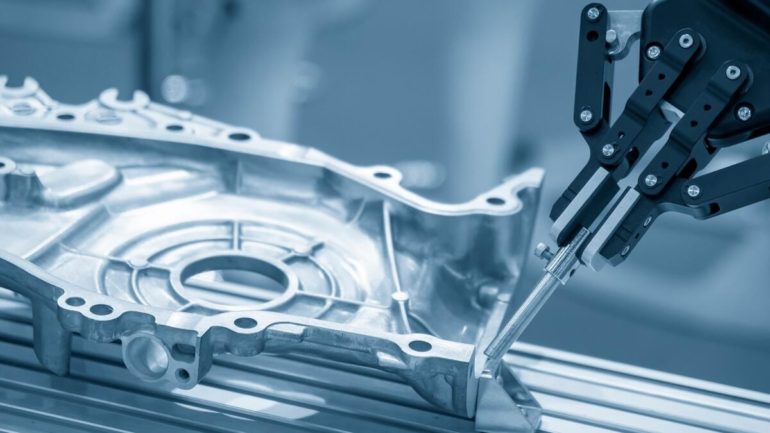A massive effort is currently underway to try and future-proof supply chains from the next major disruption. From the pandemic and ongoing product shortages to the blockage in the Suez Canal and natural disasters, companies are frantically contending with the critical need to make supply chains more resilient.
One way companies are building resiliency into supply chains is by incorporating automation within facilities to keep pace with growing consumer demand while mitigating the potential impact of external disruptions.
How can automation protect against supply chain vulnerabilities? What did we learn from the pandemic, and what are the consequences who didn’t take the lesson to heart?
I recently had a chance to connect with Jim Rock, CEO of Seegrid, a developer of mobile robots, and Ian Kinne, Director of Logistics Innovation for Hillwood, a real estate development company building new facilities with automation in mind in response to growing demand.
GN: Where are we seeing enthusiasm around automation in the supply chain and what are some arenas that have been slower to adopt industrial automation technologies?
Jim Rock (Seegrid): Enthusiasm for automation in the supply chain exists across multiple industries, but particularly in manufacturing, warehousing, e-commerce, and logistics facilities. These companies—our customers —continue to face high consumer demand and supply chain disruptions combined with pressure to remain competitive, get products to their customers faster, and retain profitability. Mobile automation through autonomous mobile robots (AMRs) is a solution to address these challenges. However, the enthusiasm for intelligent mobile automation solutions is not new, evidenced by the exponential growth and interest in mobile automation solutions since we started offering material handling automation in 2003.
Mobile automation addresses labor shortages, increases throughput, and helps businesses improve overall productivity. Our proprietary mobile automation technology is applied to manual powered pallet trucks, tow tractors, and forklifts, transforming them into autonomous mobile robots that automate material flow and deliver higher levels of productivity and safety in manufacturing facilities, logistics, and e-commerce fulfillment centers across the supply chain.
Even though interest in automation, and in particular autonomous mobile robot (AMR) automation, is increasing and more use cases are emerging, some companies are simply slower to adopt technology. We may be all moving material, but not all robotics technologies are the same, and some companies may want to test the technology to reduce perceived risk. One way to do this is to access AMRs through a subscription or Robot as a Service (RaaS) model—much like SaaS—to validate an automation provider. This approach opens the door to mobile automation for companies that want to prove the robotic solution will deliver on its promises prior to wider scale deployment.
Ian Kinne (Hillwood): Internal warehouse automation for simple, repetitive tasks has been common in warehouses for years. We saw this with auto manufacturing and parcel sort first, now it is evolving to less predictable settings utilizing equipment such as autonomous forklifts and tugs to other technologies that address everything going on outside the warehouse. Some of our customers have begun to implement autonomous yard hostlers to position trailers in their truck courts. Ultimately these will all tie into a larger autonomous freight network that companies we are working with, such as TuSimple or Kodiak, have begun to deploy within AllianceTexas and across the southern U.S.. One area that has not been addressed well is docking of autonomous tractor trailers due to safety concerns and the unloading process, especially of unpalletized freight.
GN: In what ways did the pandemic expose supply chain vulnerabilities? What are some factors that allowed some organizations to weather these disruptions better than others?
Ian Kinne: The pandemic exposed supply chains across the board, regardless of industry. Companies that fared well had a plan in place and were able to pivot quickly as ecommerce transitioned from a complementary business feature to a critical sales driver. What companies thought would take 5+ years to transition to largely ecommerce-based businesses, happened in a matter of 18 months. This acceleration of change has driven innovation across the sector and the need for creative ideas.
Jim Rock: While all industries were affected by the COVID-19 pandemic in some way, the pandemic quickly exposed vulnerabilities in many organizations’ supply chains, as consumer purchasing behaviors were heavily influenced by the COVID-19 pandemic. Many manufacturing, logistics, e-commerce, and warehousing facilities experienced extreme shifts, irregularities, and disruptions. Some had to expertly maneuver downturn impacts to ensure resiliency, while other industries had to adjust operations to fulfill record-setting order volumes because of skyrocketing demand for goods. Whether facing peaks or valleys, these challenges were compounded by labor shortages and social distancing regulations, both of which made clear the need for more automated solutions.
Companies that had established, end-to-end automation solutions were better able to pivot and evolve with the disruptions brought on by the pandemic. These automation solutions created safer work environments and allowed human workers to focus on strategic decision making and apply human perspective and insights into problem solving. Automation enables people, and the companies they work for, to be more productive and resilient in the face of ongoing supply chain pressures.
GN: What are some of the ways automation help companies stay flexible in light of growing demand and unpredictable disruptions?
Ian Kinne: Customers’ demand for consistently fast product deliveries does not change if a team at a warehouse can’t come into work or if there aren’t enough drivers to haul freight between warehouses (or to deliver to the ultimate consumer). Ultimately, automation is built to reduce the need for heavy human involvement in repetitive tasks and instead allow them to focus on more skilled requirements or customer facing roles. An example of this is the gradual shift of trucking talent from long haul routes, where drivers are away from home for the majority of the year, and shifting them to complicated urban routes where there is likely a customer interaction need. This is made possible through long haul trucking automation.
Jim Rock: Automation supports continuous improvement, so it helps companies remain flexible in endless ways. Mobile automation reduces labor and operation costs while increasing throughput, productivity, and employee safety. Mobile automation solutions like autonomous mobile robots (AMRs) can operate seamlessly alongside human workers to effectively and safely transport and deliver materials with the flexibility to pivot in the face of supply chain disruptions and operational challenges.
GN: Automation is often considered in relation to scaling up; in what ways can a thoughtful approach to automation also help a company temporarily scale back operations while minimizing shocks to the organization?
Jim Rock: Compared to the more rigid ancestral automated guided vehicles (AGVs) that relied on magnetic tape, wires, or reflectors to navigate, modern, intelligent AMRs require no infrastructure changes to a facility so they can be rapidly deployed for seamless integration into an operation. AMRs are considered ‘incremental automation’ because the robots can be deployed in phases, redeployed to other areas, add more as needed, or easily moved to another facility altogether, all without disrupting operations.
Automation is here to stay, but additional flexibility and scalability can be found through evaluating not only the technology itself, but how it is purchased. As companies look to move more quickly into automation, stay up-to-date with the latest advancements, and with less initial financial outlay and quicker returns, Seegrid recently added a Robots as a Service (RaaS) model where customers can access a Seegrid Palion AMR fleet, software and services through a subscription model for access to a complete, connected, and interoperable autonomous mobile robot fleet.
GN: When is it best to redesign operations from the ground up to incorporate automation, and when might it be preferable to take a more piecemeal approach with adaptable automation solutions?
Jim Rock: One of the benefits of infrastructure free mobile automation solutions is that it’s equally suited for use in both existing operations and in entirely new facilities. Seegrid Palion AMRs are individually equipped with our proprietary computer vision system, and can see a 3D world just like humans do to reliably operate in dynamic, ever-changing environments. Because of this, our AMRs can easily be deployed in existing facilities and workflows, and work with other forms of automation already in place such as ‘monument’ machine solutions that are too big or costly to move or adjust, like conveyors and automated storage systems. Whether the facility is semi-automated or fully automated, mobile, and collaborative robots for material handling are more attractive than ever for a flexible, intelligent, and user-friendly system that can address their safety, productivity, and output issues today, with support for growth in the future.”



